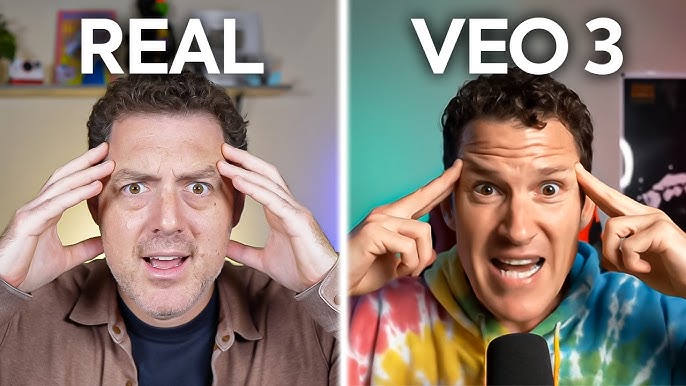Google’s Veo 3 is the shiny new toy everyone’s talking about in the AI video world. It’s Google’s latest attempt to revolutionise how we create video content, promising cinema-quality results with nothing more than a text prompt. But here’s the thing: while Veo 3 might be the future, it’s not exactly the present for most of us.
Think of Veo 3 as that expensive sports car you see in magazines. It looks incredible, performs amazingly, but the price tag makes you wonder if you really need all those bells and whistles. Sometimes, what you actually need is a reliable vehicle that gets you from point A to point B without breaking the bank.
That’s where alternatives like vidBoard come into play. While everyone’s queuing up for Veo 3’s limited access and premium pricing, vidBoard is already helping thousands of creators, marketers, and entrepreneurs turn their ideas into engaging videos today.
What Exactly Is Google Veo 3?
Google Veo 3 is an AI video generation model that creates video content from text descriptions. It’s like having a Hollywood film crew inside your computer, ready to bring any scene you can imagine to life. The model can generate videos up to 8 seconds long at resolutions reaching 4K quality, complete with synchronized audio.
What makes Veo 3 special isn’t just the video quality (though that’s impressive). It’s the first AI video generator to produce native audio alongside visuals. No more silent clips that need separate sound design. When you prompt “a cat playing piano in a jazz club,” you get the tinkling keys, ambient chatter, and maybe even some purring.
Since its launch in May 2025, over 70 million videos have been created using the platform. Enterprise customers alone have generated over 6 million videos since the June preview, showing serious commercial traction.
The 5 Veo 3 Prompt Hacks That Actually Work
1. Layer Your Scene Like a Film Director
Instead of writing “dog running,” think like Spielberg. Break your prompt into three layers:
Subject + Action + Environment + Mood
Example: “Golden retriever joyfully bounding through a sunlit meadow, wildflowers swaying in gentle breeze, warm golden hour lighting, cinematic depth of field”
This approach gives Veo 3’s AI enough detail to create something that doesn’t look like a fever dream. The model processes environmental context better when you paint the full picture.
2. Use Camera Language That AI Understands
Veo 3 has been trained on countless hours of professional footage, so it speaks “camera.” Include specific shot types and movements:
“Close-up of weathered hands kneading bread dough”
“Wide establishing shot of a bustling marketplace at sunset”
“Slow dolly zoom on a child’s surprised expression”
Pro tip: The more specific your camera instruction, the more cinematic your result. Think Netflix, not smartphone footage.
3. Master the Art of Motion Descriptions
Static prompts create static videos. Dynamic language creates dynamic content:
Instead of: “Person walking down street”
Try: “Confident businessman striding purposefully down busy city sidewalk, coat tails flowing behind him, briefcase swinging rhythmically”
Motion verbs are your secret weapon: flowing, swaying, pulsing, cascading, rippling, surging. These words help the AI understand not just what’s happening, but how it should feel.
4. Leverage Lighting and Atmosphere Keywords
Lighting makes or breaks any video. Veo 3 responds particularly well to specific lighting descriptors:
“Chiaroscuro lighting” for dramatic contrast
“Soft window light” for natural indoor scenes
“Neon-lit urban night” for cyberpunk vibes
“Dappled forest sunlight” for organic, natural feels
Example prompt: “Portrait of elderly artist painting at easel, warm studio lighting filtering through large windows, dust motes dancing in golden rays, peaceful concentration”
5. The ‘Emotion-First’ Approach
Here’s something most people miss: start with the emotion you want to convey, then build the visual around it.
Instead of describing what you see, describe what you feel:
Anxious: “Shaky handheld footage of empty corridor at night, flickering fluorescent lights casting unsettling shadows”
Triumphant: “Slow-motion confetti explosion as athlete crosses finish line, arms raised in victory, crowd roaring in background”
Peaceful: “Gentle morning mist rising from still lake surface, lone kayaker gliding silently, birds chirping softly”
This emotional scaffolding helps Veo 3 understand not just the content, but the intended impact.
Image Recommendation: Insert screenshot comparison showing a basic Veo 3 prompt result versus one using these advanced techniques.
Veo 3’s Impressive Features (And Where It Falls Short)
What Veo 3 Does Brilliantly
Native Audio Generation: Unlike competitors that produce silent videos, Veo 3 creates synchronized soundtracks including dialogue, sound effects, and music. This is genuinely revolutionary.
Resolution and Quality: The model can generate 4K video for short clips and maintains impressive visual fidelity at 1080p for longer content.
Physics Simulation: Advanced physics rendering handles complex scenarios like water flow, fabric movement, and realistic lighting better than most alternatives.
Professional Integration: Available through Google’s Vertex AI platform, making it suitable for enterprise deployment.
The Reality Check: Veo 3’s Limitations
Time Constraints: Maximum 8-second video duration severely limits storytelling potential. Try explaining your product benefits in 8 seconds.
Pricing Barriers: Google AI Pro costs £30/month, Ultra £249.99/month, with API access at $1.2 per generation. That adds up quickly for regular users.
Access Restrictions: Limited daily generations even for premium subscribers. Ultra subscribers get just 5 videos per day in Gemini, hardly enough for professional workflows.
Geographic Limitations: Photo-to-video features unavailable in EU, Switzerland, and UK due to regulatory restrictions.
Character Consistency Issues: Maintaining the same person across multiple scenes remains challenging, limiting narrative possibilities.
Veo 3 vs vidBoard: The Practical Comparison
| Feature | Veo 3 | vidBoard |
|---|---|---|
| Pricing | £30-£249.99/month | Lifetime deals starting from $99 |
| Video Length | 8 seconds max | 10-15 mins (depending on video) |
| Daily Limits | 5-125 videos | Unlimited in pro plans |
| Learning Curve | Steep prompt engineering | User-friendly interface |
| Audio Integration | Native (impressive) | Built-in music library + AI voiceover |
| Templates | None | Hundreds of templates |
| Availability | Limited beta/waiting lists | Available immediately |
| Geographic Restrictions | EU/UK limitations | Globally available |
| Enterprise Features | Advanced API | Contact Support |
The honest truth? Veo 3 produces technically superior individual clips, but vidBoard offers a complete video creation solution that’s actually accessible to normal humans with normal budgets.
How to Achieve Similar Results in vidBoard
While vidBoard doesn’t use the exact same AI model as Veo 3, you can create compelling videos using similar principles:
vidBoard’s Template + AI Approach
Instead of: Struggling with perfect Veo 3 prompts
Try: Starting with vidBoard’s professionally designed templates and customising with AI-powered tools
Example workflow:
Choose a template that matches your video’s purpose
Replace placeholder content with your message
Use AI voiceover generation for professional narration
Apply automated scene transitions and effects
Combining Multiple Short Clips
Since Veo 3’s 8-second limit restricts storytelling, vidBoard’s approach of combining multiple scenes into longer narratives often produces more useful final products.
vidBoard advantage: You can create complete stories, tutorials, and presentations rather than impressive but impractical 8-second clips.
Image Recommendation: Insert side-by-side comparison of a Veo 3 8-second clip versus a complete vidBoard video telling the same story.
Real-World Use Cases: Where Each Tool Shines
For Small Business Owners
Veo 3 scenario: You’re a local restaurant owner wanting to showcase your signature dish. You craft the perfect prompt: “Steam rising from perfectly plated pasta carbonara, chef’s hands adding final parmesan garnish, warm kitchen lighting, appetising close-up.” Result: 8 seconds of beautiful footage that costs £1.20 and took 20 minutes to perfect.
vidBoard scenario: You use a restaurant template, add your own food photos, include customer testimonials, explain your story, and add opening hours. Result: 60-second complete marketing video ready for social media, website, and advertising.
For Content Creators and Educators
Teaching professionals find Veo 3’s technical complexity and time limits frustrating. Creating educational content requires clear explanations, not just pretty visuals.
vidBoard’s strength lies in its educational templates and easy workflow. Teachers can create complete lessons, tutorials, and explanatory videos without becoming AI prompt engineers.
For Marketing Teams
Enterprise marketing teams using Veo 3 report 73% improvements in content creation efficiency, but struggle with the platform’s limitations for campaign-scale content creation.
The Technical Reality Behind the Hype
What the Statistics Really Mean
Yes, over 70 million videos have been created since May 2025, but context matters. Many of these are experimental clips from users testing the technology, not finished products used in real business applications.
Enterprise adoption of 6 million videos sounds impressive until you realise these are often individual scenes requiring assembly into complete videos using other tools anyway.
The Hidden Costs of “Free” Innovation
Veo 3’s impressive capabilities come with hidden complexity costs:
Learning curve: Mastering effective prompts takes weeks of experimentation
Iteration time: Each generation takes 3-5 minutes, and perfect results rarely happen on the first try
Post-production: 8-second clips still need editing, audio mixing, and assembly for practical use
Performance vs Practicality
Veo 3 Fast offers 2x faster generation at 720p resolution, but even “fast” AI video generation involves significant waiting time compared to template-based creation.
vidBoard’s real-time editing allows immediate feedback and adjustments, often resulting in faster total creation time despite less sophisticated underlying AI.
Future Outlook: Where AI Video Is Heading
The Industry Trajectory
The AI video generation market is projected to grow from $534.4 million in 2024 to $2.56 billion by 2032, representing a 19.5% annual growth rate. This explosion is driven by increasing demand across multiple sectors.
What This Means for Users
Short-term (2025-2026): Expect continued improvements in video quality and length limits. Google will likely extend Veo 3’s 8-second restriction and reduce pricing as competition intensifies.
Medium-term (2027-2028): Integration between AI generation and practical video editing tools will become standard. The winners won’t be the most technically impressive models, but the most useful complete solutions.
Long-term (2029+): AI video creation will become as common as photo editing today. The focus will shift from technical capability to ease of use and practical application.
vidBoard’s Strategic Position
While others chase the latest AI developments, vidBoard focuses on solving real user problems today. This approach positions them well for sustained growth as the market matures and users prioritise practical solutions over technical novelty.
Image Recommendation: Insert infographic showing the AI video market growth trajectory and positioning of different tools.
Frequently Asked Questions
Is Veo 3 available to the public?
Veo 3 is available through Google Gemini and Vertex AI, but access is limited by subscription tiers and daily generation quotas. Google AI Pro subscribers get basic access, while Ultra subscribers receive higher limits and additional features.
Can I use Veo 3 on my phone?
Yes, Veo 3 is accessible through the Google Gemini mobile app for supported devices. However, the mobile experience has the same limitations as desktop access, including 8-second video duration and daily generation limits.
What is the difference between Veo 3 and Veo 3 5G?
This appears to be a confusion with terminology. Veo 3 Fast is the speed-optimised version that generates videos 2x faster than standard Veo 3, but at 720p resolution instead of 4K. There isn’t a “Veo 3 5G” model.
How much does Veo 3 cost?
Google AI Pro costs £30/month for basic Veo 3 access, while Google AI Ultra costs £249.99/month for expanded features. Enterprise API access costs $1.2 per generation for 8-second videos at 720p resolution.
What is the alternative to Google Veo 3?
Several alternatives exist, including OpenAI’s Sora, Runway ML, and Pika Labs for AI generation. For practical video creation with templates and easier workflows, vidBoard offers a more accessible approach with longer video capabilities and lower learning curves.
Can you go live on social media with Veo Cam 3?
This question confuses Veo 3 (AI video generator) with Veo Cam 3 (sports camera hardware). Veo Cam 3 does support live streaming for sports analysis, but Google’s Veo 3 AI model generates pre-recorded video content only.
How long can a Veo 3 video be?
Current Veo 3 videos are limited to 8 seconds maximum duration. This restriction significantly limits storytelling and practical business applications compared to traditional video creation tools.
Can ChatGPT generate videos?
No, ChatGPT cannot directly generate videos. OpenAI’s Sora is their video generation model, which remains in limited preview access. ChatGPT can help write video scripts and concepts, but cannot create the actual video content.
Is Gemini better than ChatGPT?
This depends on specific use cases. Gemini offers integrated Veo 3 video generation capabilities that ChatGPT lacks, but ChatGPT often provides superior text generation and reasoning for many applications. For video creation specifically, Gemini’s Veo 3 integration gives it a significant advantage.
The Bottom Line: Choose Your Tool Based on Your Needs
Veo 3 represents genuine innovation in AI video generation. The quality is impressive, the technology is cutting-edge, and the potential is enormous. But potential doesn’t pay the bills or create the content your audience needs today.
Choose Veo 3 if:
You need the absolute highest video quality for individual clips
You have time to master complex prompt engineering
Your budget supports £30-£249.99 monthly subscriptions plus per-generation costs
You’re comfortable with 8-second video limitations
You work within supported geographic regions
Choose vidBoard if:
You need complete videos that tell full stories
You prefer user-friendly interfaces over technical complexity
You want predictable pricing without per-generation charges
You need team collaboration and workflow features
You want results today, not after weeks of learning
The future of video creation isn’t just about the most advanced AI models. It’s about tools that help real people create real content for real audiences without requiring computer science degrees.
Ready to create professional videos without the complexity? Try vidBoard free for 7 days and see how easy video creation can be when the tools work for you, not against you. No prompts required, no daily limits, no waiting lists. Just great videos, made simple.
Your story deserves to be told. The only question is whether you want to spend your time mastering AI prompts or actually creating content that connects with your audience.
Join vidBoard today and join thousands of creators who’ve discovered there’s a better way to make videos that matter.
























